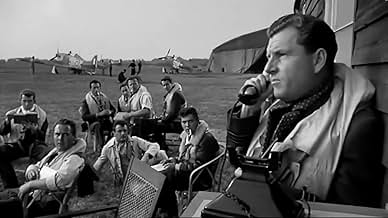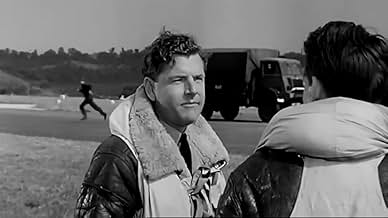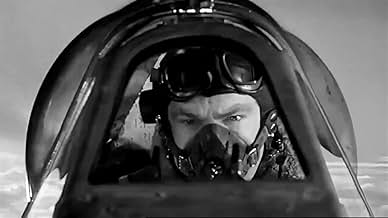AVALIAÇÃO DA IMDb
7,2/10
3,1 mil
SUA AVALIAÇÃO
Adicionar um enredo no seu idiomaBiopic of RAF Group Captain Douglas Bader who, after having lost both legs, flew a British fighter plane during WWII.Biopic of RAF Group Captain Douglas Bader who, after having lost both legs, flew a British fighter plane during WWII.Biopic of RAF Group Captain Douglas Bader who, after having lost both legs, flew a British fighter plane during WWII.
- Direção
- Roteiristas
- Artistas
- Ganhou 1 prêmio BAFTA
- 1 vitória e 4 indicações no total
Howard Marion-Crawford
- 'Woody' Woodhall
- (as Howard Marion Crawford)
- Direção
- Roteiristas
- Elenco e equipe completos
- Produção, bilheteria e muito mais no IMDbPro
Avaliações em destaque
For those who have seen and enjoyed "The Dam Busters"(1954) about British Bomber Command in WWII, this bio-pic about Douglas Bader and British Fighter Command provides an excellent companion film. Douglas Bader (pronounced "Baader") is excellently portrayed by Kenneth More in another stirring British Bulldog role, (see also his role of 2nd Officer Lightoller in "A Night to Remember (1958).Our hero joins Cranwell (British RAF Officer Flying School) in 1928 and soon proves he has natural flying ability.He also excells at cricket and rugby but is not so hot at the academics coming 17/19 in the exams.Discipline is also a bit of a problem for him and he has to learn that "...rules are for the obedience of fools and for the guidance of wise men".At Cranley he meets a friend, and the two fly over to the Reading Flying Club in the early 1930's when Bader rashly accepts a dubious challenge to exhibit his aerobatic skill when the crowds are not present.The result was a near fatal crash that resulted in him having both legs amputated.The scene with nurse Brace is genuinely touching - I have seen this film many times and it always brings a tear to my eye.While recovering with other injured men they go on a jaunt in one of the chap's Bentley with Douglas, as usual, driving at breakneck speed with his peg leg on the accelerator.Miraculously they all arrive in one piece at a tea room and it is there that Douglas meets Thelma who is helping a friend by waiting on table "...cream or plain?".On a return trip to the cafe Douglas is distraught to see Thelma in the company of a young man coming out of the rain but is then relieved when she informs him that he is her brother.They informally marry and as there was nothing in "King's Regulations" about cripples being able to continue flying in the RAF and since a desk job was not to Bader's liking, he left and got a mundane job in civvy street.Although cricket and rugby were now ruled out, he did find he could compete on level terms at golf.The film shows the very determined spirit of Bader as he struggles to come to terms with his appalling injuries and after many falls, his success in being able to literally stand on his own two (though artificial) feet.
Ominously a news stand proclaims, "Hitler succeeds Hindenberg".That was 1933.The action moves forward to 1940 and as Britain had been at war with Germany since September 1939, it was looking for trained RAF pilots.Bader once again applies and passes his flying test but there still are, "Kings Regulations", to overcome.Bader confronts the medical officer with irrefutable logic and this time is accepted back into the officer fold.He is given a squadron of Canadian pilots (which includes the future famous group captain Turner, played by Lee Paterson) who are very dispirited because they have lost most of their uniforms and equipment in France after the hasty evacuation of the B.E.F. at Dunkirk in May 1940.To win their respect he gives a tour de force of his flying skill to prove that, although he has tin legs, this does not dim his fierce determination to succeed.His injuries have also instilled into him a combative approach and fierce loyalty and friendship to his men which is soon reciprocated by them.However, there are apparantly no spares to make the Hawker Hurricanes serviceable and as we all know, forms have to be completed in triplicate!."What seems to be the problem" asks Bader to his chief mechanic."The channels appear to be blocked" is the reply."Well we shall ruddy well have to unblock them" Bader says uncompromisingly and he then goes over the head of the pettifogging quartermaster by telling Group that his squadron is not operational without parts and spares.How the viewer will applaud this slayer of bureaucrats!Eventually the spares arrive and Bader is then able to report to Group that his squadron is finally operational.
The film artfully splices actual RAF WWII combat footage in this B&W film and shows the success Bader's new approach to the old idea of formation flying had with the top brass.Eventually Bader becomes Wing Commander of "The Duxford Wing".Early in the war Bader's luck runs out and he is shot down over France.The Germans even ask the RAF to drop a spare artificial leg down, as he left the other jammed in the cockpit when he baled out.He fails to escape and is made a P.O.W.Mocking the Germans (or "Goon Baiting") got him into trouble and he is moved from camp to camp , eventually ending up at the notorious Colditz Castle where he ends the war.After the German surrender in May 1945 he reminds Thelma there is still the war against Japan to be waged.
This film depicts the public school ethos of officers in the RAF very well with the usual British phlegm, reserve and applomb shown in British war movies of the 1950's.Every actor is very convincing in his part and I always enjoy acted real life docu-dramas - so much more convincing than mere fiction.I hope readers of this review who are like-minded, will similarly enjoy viewing this great WWII movie.
Ominously a news stand proclaims, "Hitler succeeds Hindenberg".That was 1933.The action moves forward to 1940 and as Britain had been at war with Germany since September 1939, it was looking for trained RAF pilots.Bader once again applies and passes his flying test but there still are, "Kings Regulations", to overcome.Bader confronts the medical officer with irrefutable logic and this time is accepted back into the officer fold.He is given a squadron of Canadian pilots (which includes the future famous group captain Turner, played by Lee Paterson) who are very dispirited because they have lost most of their uniforms and equipment in France after the hasty evacuation of the B.E.F. at Dunkirk in May 1940.To win their respect he gives a tour de force of his flying skill to prove that, although he has tin legs, this does not dim his fierce determination to succeed.His injuries have also instilled into him a combative approach and fierce loyalty and friendship to his men which is soon reciprocated by them.However, there are apparantly no spares to make the Hawker Hurricanes serviceable and as we all know, forms have to be completed in triplicate!."What seems to be the problem" asks Bader to his chief mechanic."The channels appear to be blocked" is the reply."Well we shall ruddy well have to unblock them" Bader says uncompromisingly and he then goes over the head of the pettifogging quartermaster by telling Group that his squadron is not operational without parts and spares.How the viewer will applaud this slayer of bureaucrats!Eventually the spares arrive and Bader is then able to report to Group that his squadron is finally operational.
The film artfully splices actual RAF WWII combat footage in this B&W film and shows the success Bader's new approach to the old idea of formation flying had with the top brass.Eventually Bader becomes Wing Commander of "The Duxford Wing".Early in the war Bader's luck runs out and he is shot down over France.The Germans even ask the RAF to drop a spare artificial leg down, as he left the other jammed in the cockpit when he baled out.He fails to escape and is made a P.O.W.Mocking the Germans (or "Goon Baiting") got him into trouble and he is moved from camp to camp , eventually ending up at the notorious Colditz Castle where he ends the war.After the German surrender in May 1945 he reminds Thelma there is still the war against Japan to be waged.
This film depicts the public school ethos of officers in the RAF very well with the usual British phlegm, reserve and applomb shown in British war movies of the 1950's.Every actor is very convincing in his part and I always enjoy acted real life docu-dramas - so much more convincing than mere fiction.I hope readers of this review who are like-minded, will similarly enjoy viewing this great WWII movie.
What do you mean, you haven't seen this film? A classic World War 2 RAF adventure film depicting the true British spirit of one man's (Douglas Bader) fight to overcome the loss of both legs in a flying accident, to become a Wing Commander in the Battle of Britain. Lewis Gilbert keeps the film crackling along at a fast pace with Kenneth More, at the peak of his form, delivering the goods with a first rate supporting cast - don't miss it.
It's always encouraging to see the indomitable human spirit gain control against all odds. How easy it would have been for pilot Douglas Bader, played by Kenneth More here, to simply give in to circumstances, drop out of active life, and lead a limited existence all because of a dreadful plane accident in which he lost both legs. But he didn't choose to go that way, and with the advent of WW2 he managed to resume his active pilot career despite the fact of having artificial legs, and had more than a few adventures which he survived. I like this movie for its positive grasp of life and living, and shows that you can create your world if you have singleminded determination. Also of interest were the real life film footage of aerial manoeuvrings used from the war. I'd recommend this war movie any time.
The credits advise that some events and depictions of people/events have been altered for story telling purposes , so this film is not a strictly accurate history of Douglas Bader. Also played down somewhat is Baders arrogance and foolhardiness which lead to his disability in the first place. Still as a inspiration for disabled people and as an almost factual account of Baders life and as film entertainment , it's pretty good. Made reasonably close to the war years it is able to capture the feeling of those years quite well. It is a trifle 'stiff upper lip - what ?' but Kenneth More as usual turns in a good performance. Focusing mainly on Baders attempts, and resulting achievements in war time flying, after a crash means both lower legs have to be amputated. Quite gritty and not too sentimental this offering from director Lewis Gilbert stacks up well against similar films of the time.
Douglas Bader (1910-1982) was one of Britain's most popular heroes of WWII, a celebrated combat pilot and Flight Commander. His triumphs during the Battle of Britain proved significant in the Allied victory. In 1941, after he was taken prison in German-occupied France, Bader caused headaches for the enemy with repeated escape attempts, and he was eventually confined to Colditz Castle, a prisoner-of-war camp reserved for such trouble-cases. And did I mention that he did all these things without the use of his legs? On December 14, 1931, Douglas Bader had crashed his aeroplane while attempting low-altitude maneuvers, sustaining such injuries that doctors were forced to amputate both legs. The characteristically resilient pilot later understated the gravity of his disaster with this laconic note in his logbook: "Crashed slow-rolling near ground. Bad show." Following the success of Paul Brickhill's biography, British director Lewis Gilbert (most noted for later directing several James Bond films) brought Bader's story to life, an inspirational testament to a man for whom "impossible" was not a word.
The natural comparison for 'Reach for the Sky (1956)' is Wyler's 'The Best Years of Our Lives (1946),' which starred a real-life war veteran (Harold Russell) who had lost both arms in combat. There are biographical distinctions, of course – Bader lost his limbs in peace- time, and later fought while "disabled" – but the basic theme of overcoming one's handicaps through hope and determination holds firm. Kenneth More {whom I recently discovered in the gripping Titanic docu- drama 'A Night to Remember (1958)'} brings a likable cockiness and fierce determination to the leading role. Bader's dogged resolve at times seems terse and even stubborn; his notion of success appears to hinge upon rejecting the helping hands of friends and loved ones. In his attitudes, there is a certain conceitedness, perhaps a necessary attribute for a pilot who rose to the military rank of Group Captain. More's portrayal certainly imparts these elements of vanity, but one can't help but be inspired by a man whose never-say-die outlook knows no bounds.
Muriel Pavlow plays Bader's wife, Thelma, a delicate woman who seems unfairly neglected while her husband chases his ambitions. Though given substantially less screen-time, the film's most interesting female character, I thought, was Dorothy Alison's nurse, who tends Bader back to health following his accident. Her appearance is brief, but incredibly subtle: just watch the series of conflicting emotions flicker across her face as Bader departs, love and sadness and everything in between. I had expected the nurse to make an appearance later in the film, but she appears to have been shunned permanently from Bader's life. This ties in nicely with the leading character: after resolving himself to be entirely self-sufficient, he must reject the one woman on whom he once relied so heavily. In Wyler's film, Russell's character accepts that he'll never be entirely independent, and it's only fitting that he should marry a woman who'll always be there to offer a helping hand. Bader rejects this helping hand; he's not much of a husband, but he is one hell of a battler.
The natural comparison for 'Reach for the Sky (1956)' is Wyler's 'The Best Years of Our Lives (1946),' which starred a real-life war veteran (Harold Russell) who had lost both arms in combat. There are biographical distinctions, of course – Bader lost his limbs in peace- time, and later fought while "disabled" – but the basic theme of overcoming one's handicaps through hope and determination holds firm. Kenneth More {whom I recently discovered in the gripping Titanic docu- drama 'A Night to Remember (1958)'} brings a likable cockiness and fierce determination to the leading role. Bader's dogged resolve at times seems terse and even stubborn; his notion of success appears to hinge upon rejecting the helping hands of friends and loved ones. In his attitudes, there is a certain conceitedness, perhaps a necessary attribute for a pilot who rose to the military rank of Group Captain. More's portrayal certainly imparts these elements of vanity, but one can't help but be inspired by a man whose never-say-die outlook knows no bounds.
Muriel Pavlow plays Bader's wife, Thelma, a delicate woman who seems unfairly neglected while her husband chases his ambitions. Though given substantially less screen-time, the film's most interesting female character, I thought, was Dorothy Alison's nurse, who tends Bader back to health following his accident. Her appearance is brief, but incredibly subtle: just watch the series of conflicting emotions flicker across her face as Bader departs, love and sadness and everything in between. I had expected the nurse to make an appearance later in the film, but she appears to have been shunned permanently from Bader's life. This ties in nicely with the leading character: after resolving himself to be entirely self-sufficient, he must reject the one woman on whom he once relied so heavily. In Wyler's film, Russell's character accepts that he'll never be entirely independent, and it's only fitting that he should marry a woman who'll always be there to offer a helping hand. Bader rejects this helping hand; he's not much of a husband, but he is one hell of a battler.
Você sabia?
- CuriosidadesRichard Burton was the first choice for the lead but he dropped out after he was offered the lead in Alexandre Magno (1956) at what Lewis Gilbert describes as "three or four times the salary".
- Erros de gravaçãoWhen Bader is demonstrating his ability to fly the Hurricane to his new squadron of Canadian pilots, there is a long cut of the plane flying upside-down in a straight line. This was impossible in the Hurricane, as it had a gravity-fed carburettor. If you look carefully at the clouds, and how the sunlight reflects from them, the image has clearly been inverted.
- Versões alternativasOriginally released in Great Britain at 135 minutes; cut by 12 minutes before the American premiere.
- ConexõesFeatured in Century of Cinema: Cinema of Unease: A Personal Journey by Sam Neill (1995)
Principais escolhas
Faça login para avaliar e ver a lista de recomendações personalizadas
- How long is Reach for the Sky?Fornecido pela Alexa
Detalhes
- Data de lançamento
- País de origem
- Idiomas
- Também conhecido como
- Reach for the Sky
- Locações de filme
- Empresas de produção
- Consulte mais créditos da empresa na IMDbPro
Bilheteria
- Orçamento
- £ 380.000 (estimativa)
- Tempo de duração2 horas 15 minutos
- Cor
- Proporção
- 1.85 : 1
Contribua para esta página
Sugerir uma alteração ou adicionar conteúdo ausente

Principal brecha
By what name was O Céu ao Seu Alcance (1956) officially released in India in English?
Responda































